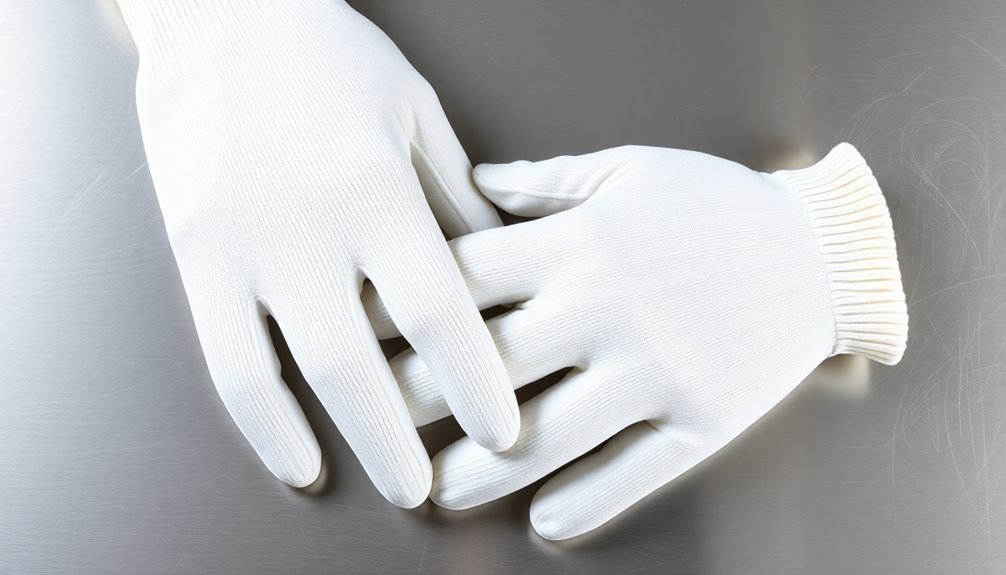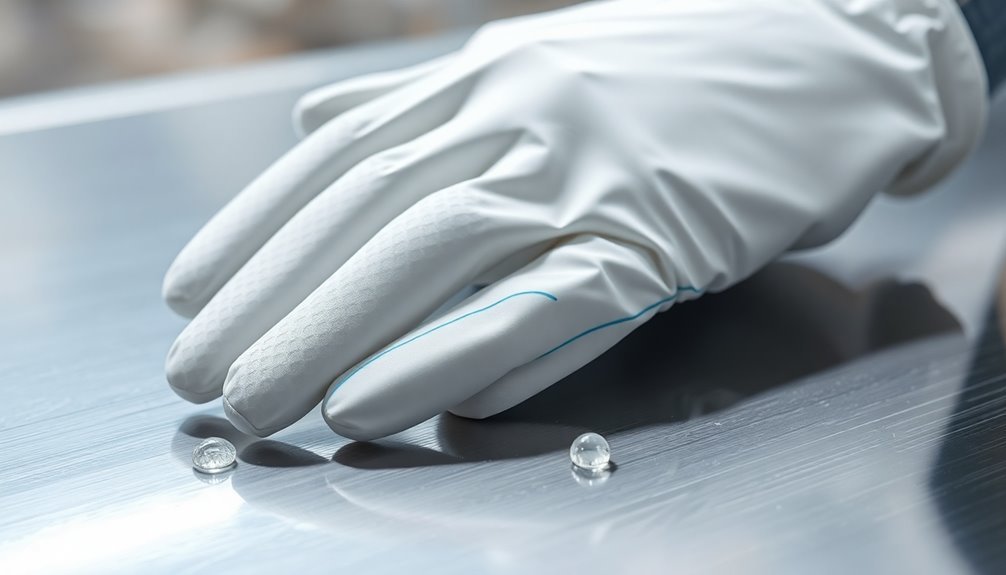For advanced cleanroom protection, you'll want to evaluate three top antistatic glove options. Polyester ESD gloves with integrated carbon fibers offer superior static control and heat resistance up to 302°F, making them ideal for semiconductor work. Chemical-resistant nitrile gloves provide excellent protection while meeting OSHA standards and cleanroom requirements through double-bagged packaging. Cut-resistant gloves featuring UHMWPE fibers with polyurethane-coated palms deliver enhanced grip and durability for more demanding tasks. Each option brings unique advantages to your cleanroom environment, and understanding their specific features will help you make the best choice for your application.
Polyester ESD Technology

Three key components make up the foundation of Polyester ESD Technology: a polyester knit base, integrated carbon fibers, and a specialized inner tricot liner. This combination delivers both static control and heat resistance up to 302°F (150°C), making it ideal for cleanroom environments where you'll need thorough protection. The less-linting filament construction ensures minimal particle generation during use.
You'll find the technology particularly effective in semiconductor and electronics manufacturing settings, where the gloves' electrical RTT of less than 1 x 10^10 Ohms/Sq. guarantees reliable static dissipation. The 14-inch length provides extensive coverage, while the cuff-mounted grounding snap guarantees secure static control throughout your work.
When you're handling printed circuit boards or working with hybrid circuits, you'll benefit from the gloves' low tribocharging properties, typically maintaining less than 300 volts. The inner tricot knit polyester fabric liner enhances your heat protection while maintaining tactile sensitivity.
You can maintain these gloves easily as they're machine washable with mild detergent, though you'll need to avoid bleach and dryer use. The technology's adaptability means you can choose from various sizes to guarantee a perfect fit for your cleanroom applications.
Chemical Resistant Nitrile Solutions
Nitrile solutions stand out in cleanroom environments by meeting rigorous chemical resistance standards, including OSHA Standard -29 CFR 1915.157 and multiple EN certifications. You'll find these gloves are specifically engineered to provide superior solvent resistance while maintaining essential ESD protection for sensitive electronic components.
- Powder-free construction eliminates particulate contamination risks
- Double-bagged cleanroom packaging guarantees pristine condition upon arrival
- Bisque finish improves grip without compromising chemical resistance
- Testing compliant with ASTM 739 permeation standards for chemical safety
When you're working in semiconductor, photovoltaic, or food processing environments, these nitrile gloves deliver extensive protection. The 15 milli-inch gauge construction ensures optimal durability and tactile sensitivity. They're designed with a straight cuff for easy wear and feature robust abrasion and puncture resistance that meets EN388 requirements.
For peak safety, you'll want to replace them after two hours of use or immediately upon visible contamination. It's recommended to wear double layers to quickly detect any breaches in protection.
Store your nitrile gloves in their original packaging, away from direct sunlight, at temperatures between 50°F and 86°F to maintain their protective properties. This careful storage guarantees they'll maintain their chemical resistance and ESD protection capabilities.
Cut Protection And Durability

Guaranteeing proper cut protection in cleanroom environments requires specialized materials and construction techniques.
You'll find two main types of protective gloves: cut-and-sewn options that use either full or palm-lined cut-resistant materials, and seamless knitted gloves manufactured with high-performance UHMWPE fibers in one piece. Dual protective features eliminate the need for maintaining separate glove inventories.
When you're selecting cut-resistant gloves, look for those featuring Dyneema or UHMWPE threads, as they provide superior protection against cuts while maintaining excellent abrasion and tear resistance.
For enhanced grip, choose models with polyurethane-coated palms. You'll want to verify that your gloves meet EN388 4342 standards and achieve at least ANSI Cut Level 3 for basic protection.
Don't compromise on electrical safety – confirm your antistatic gloves maintain a surface resistance of 10^7 ohms per ANSI/ESD STM15.1.
For thermal applications, check RTT values below 1 x 10^10 Ohms/Sq.
These gloves are washable and reusable, but you'll need to follow specific care instructions: use mild detergent, avoid bleach, and skip the dryer.
Frequently Asked Questions
How Often Should Antistatic Gloves Be Tested for Their ESD Protection Effectiveness?
You should test your ESD gloves daily before use, but if you're handling highly sensitive components, you'll want continuous monitoring. Don't forget to document your testing frequency in your ESD control plan.
Can Antistatic Gloves Be Worn Over Regular Medical Gloves in Cleanrooms?
You shouldn't wear antistatic gloves over medical gloves in cleanrooms. It can compromise ESD protection, reduce dexterity, and affect proper fit. Instead, choose gloves specifically designed for your cleanroom's requirements.
What Temperature Indicates Antistatic Gloves Need Immediate Replacement?
You'll need to replace your antistatic gloves immediately if they exceed their material-specific limits – for example, 200°F for cotton, 300°F for Kevlar, or if you notice any signs of damage or degradation.
Do Antistatic Properties of Gloves Change When Exposed to High Humidity?
Yes, your antistatic gloves' properties will change in high humidity. You'll notice increased conductivity as moisture enhances static dissipation, but don't rely solely on this effect – maintain proper ESD controls regardless.
Are There Specific Storage Requirements to Maintain Antistatic Gloves' Protective Properties?
You'll need to store your antistatic gloves between 10-25°C in dry, well-ventilated areas away from sunlight. Keep them in their original packaging and avoid humidity fluctuations to maintain their protective properties.
In Summary
You'll find reliable protection against electrostatic discharge with any of these three advanced cleanroom glove options. Whether you choose polyester ESD technology for comfort, nitrile solutions for chemical resistance, or reinforced gloves for cut protection, you're getting industry-leading safety standards. Don't compromise when it comes to cleanroom safety – select the glove that best matches your specific workplace requirements.





Leave a Reply